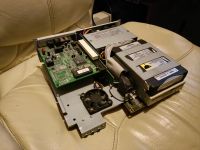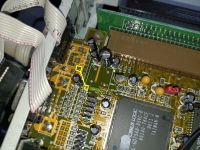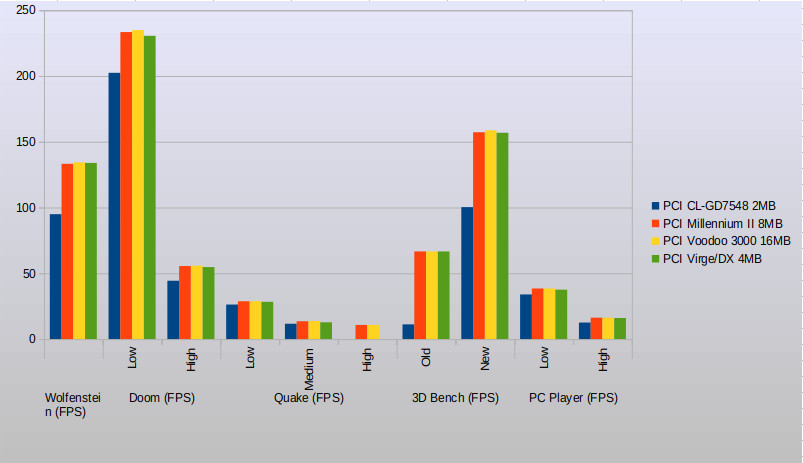Table of Contents
Digipos Pro
This is a point-of-sale system which I bought as non-working in December 2022. It was listed as powering on, but displayed no output and output a number of beep error codes. The problem turned out to be relatively easy to fix - the included single 16MB SIMM module was either faulty or incompatible and after replacing it with two 32MB EDO SIMM's from my spares it powered on correctly.
Case Pictures
Internals
Motherboard
Specification
Original Specification
- Processor: IDT Winchip C6 200MHz
- Motherboard: DTV-07 Ali Aladdin M1521, Socket 7, 512KB Pipeline Burst cache, 2x 72pin EDO SIMM sockets, 3x ISA + 2x PCI (3 total max.)
- Video: Onboard Cirrus Logic GD-7548 (PCI)
- Storage: 3.5“ Floppy + 4.3GB Seagate IDE
Current Specification
- Processor:
IDT Winchip C6 200MHzIntel Pentium MMX 200MHz - Motherboard: DTV-07 Ali Aladdin M1521, Socket 7, 512KB Pipeline Burst cache, 2x 72pin EDO SIMM sockets, 3x ISA + 2x PCI (3 total max.)
- Video: S3 Virge/DX 4MB (PCI)
- Network: Realtek RTL8139 10/100 + XT-IDE ROM
- Audio: Labtec ESS Audiodrive 1868F
- Storage: 3.5” bay mounted Compact Flash reader
Faults & Fixes
Memory
As I said in the introduction, this was supplied with a single faulty 16MB SIMM and was fine after replacing it with two 32MB EDO modules.
Keyboard
After powering on the system for the first time I had ongoing issues with the keyboard not working, my KVM not detecting a keyboard, and, when the keyboard did work, the key repeat feature would not work. I also had trouble getting several types of PS/2 keyboard recognised (a basic Dell keyboard wouldn't even power up). Looking at the +5v line of the AT keyboard connector it was fine, and I tried multiple BIOS images without any improvement.
Eventually I started poking about near the AT connector on the motherboard and notice what appeared to be the typical PS/2 keyboard fuse:
Testing that for continuity I got really bizarre resistance readings, so I decided to bypass it - at that point the keyboard started to work properly. I'm not sure what failure mode the fuse was in, but it certainly hadn't 'failed open', which is what I would have expected. Anyway, bypassing it with a wire link proved that it was at fault, and my Dell keyboard came to life:
Noisy Fans
The system uses a 40x40x10mm fan over the custom PSU as well as a 50x50x10mm fan over the heatsink/heatpipe, both of which were noisy. They were removed and replaced with much bigger, slower spinning items.
Removal of Custom PSU
No standard AT/ATX PSU in this thing - it was entirely bespoke, with a bespoke motherboard header. I decided to remove the 25+ year old PSU and replace it with a modern, solid state, cool-running PicoPSU instead:
[Update] After fitting the Pentium MMX processor the PicoPSU wasn't up to the task, leading to random reboots when changing video mode, running benchmarks etc. Removal of the PicoPSU and plugging a standard ATX PSU into the breakout header stopped all of the reboots, so clearly the power draw of the Pentium 200 is at the limit (and just beyond) of what the PicoPSU can deliver. I'll need to replace it with a bigger unit - the original custom supply with it's horrible 40mm fan is not going back!
Resources
Motherboard Manual
BIOS Images
Benchmarks
| Configuration 1 | Configuration 2 | Configuration 3 | Configuration 4 | ||
|---|---|---|---|---|---|
| C6 200MHz | C6 200MHz | C6 200MHz | C6 200MHz | ||
| 2x32MB EDO | 2x32MB EDO | 2x32MB EDO | 2x32MB EDO | ||
| PCI CL-GD7548 | PCI Millenium II | PCI Voodoo 3000 | PCI Virge/DX | ||
| Test | Metric | ||||
| Norton | CPU Score | 429.9 | 429.9 | 429.9 | 429.9 |
| Comptest | CPU Cache throughput | 249554 KB/sec | 249554 KB/sec | 249554 KB/sec | 249554 KB/sec |
| Comptest | RAM throughput | 90991 KB/sec | 90991 KB/sec | 90991 KB/sec | 90991 KB/sec |
| Comptest | Extended RAM throughput | 32731 KB/sec | 32731 KB/sec | 32731 KB/sec | 32731 KB/sec |
| Comptest | Dhrystones | 138675 | 138675 | 138675 | 138675 |
| Comptest | KWhetstones | 53233 | 53233 | 53233 | 53233 |
| Comptest | MegaFLOPS | 7.789 | 7.789 | 7.789 | 7.789 |
| Comptest | Disk throughput | 1894 KB/sec | 1894 KB/sec | 1894 KB/sec | 1894 KB/sec |
| Landmark | CPU of emulated PC/AT | 928 MHz | 928 MHz | 928 MHz | 928 MHz |
| Landmark | FPU of emulated PC/AT | 1319 MHz | 1319 MHz | 1319 MHz | 1319 MHz |
| Landmark | Video | 8548 | OFF SCALE | OFF SCALE | OFF SCALE |
| Speedsys | CPU Performance | 130.27 | 130.27 | 130.27 | 130.27 |
| Speedsys | L1 Cache | 263 MB/sec | 263 MB/sec | 263 MB/sec | 263 MB/sec |
| Speedsys | L2 Cache | 142 MB/sec | 142 MB/sec | 142 MB/sec | 142 MB/sec |
| Speedsys | RAM Throughput | 108 MB/sec | 108 MB/sec | 108 MB/sec | 108 MB/sec |
| Speedsys | RAM Bandwidth | 224 MB/sec | 224 MB/sec | 224 MB/sec | 224 MB/sec |
| Wolfenstein 3D | FPS | 94.9 FPS | 133.2 FPS | 134.3 FPS | 133.9 FPS |
| DOOM | Low Detail | 202.41 FPS | 233.41 FPS | 234.87 FPS | 230.52 FPS |
| DOOM | High Detail | 44.33 FPS | 55.45 FPS | 55.70 FPS | 54.72 FPS |
| Quake | 320×240 | 26.2 FPS | 28.7 FPS | 28.7 FPS | 28.3 FPS |
| Quake | Medium | 11.6 FPS | 13.5 FPS | 13.7 FPS | 12.7 FPS |
| Quake | 640×480 | N/A | 10.7 FPS | 10.7 FPS | N/A |
| 3D Bench | 1.0c | 100.3 FPS | 157.2 FPS | 158.7 FPS | 156.8 FPS |
| PC Player | Low Res | 33.9 FPS | 38.4 FPS | 38.4 FPS | 37.5 FPS |
| PC Player | High Res | 12.5 FPS | 16.2 FPS | 16.2 FPS | 16 FPS |
Comparison of the VGA benchmarks side by side for the IDT Winchip C6 configurations:

















